The Pros and Cons of Supplier Self-Onboarding


Key Takeaways:
What if the key to faster procurement, lower operational costs, and a more agile supply chain is letting suppliers do the onboarding themselves?
It sounds efficient—but is it too good to be true?
As companies scale and procurement processes grow more complex, supplier self-onboarding becomes an increasingly attractive option.
It promises to streamline vendor integration, reduce administrative workload, and improve data accuracy.
But with these advantages come real drawbacks, too.
In this article, we’ll explore both, helping you determine whether it’s the right approach for your organization’s needs.
First, let’s start with the benefits of supplier self-onboarding.
If you’re looking to cut procurement costs, supplier self-onboarding is an effective solution.
By reducing the need for manual administrative support, it significantly lowers labor and overhead expenses, saving you paper, postage, and other resources.
That’s especially valuable when onboarding multiple vendors at once.
Ultimately, this can make a world of difference for your budget, as supplier onboarding is a notoriously expensive process.
According to a 2024 HICX article, a median company with $5 billion in annual spend can spend over $1 million per year on labor costs for supplier onboarding alone.
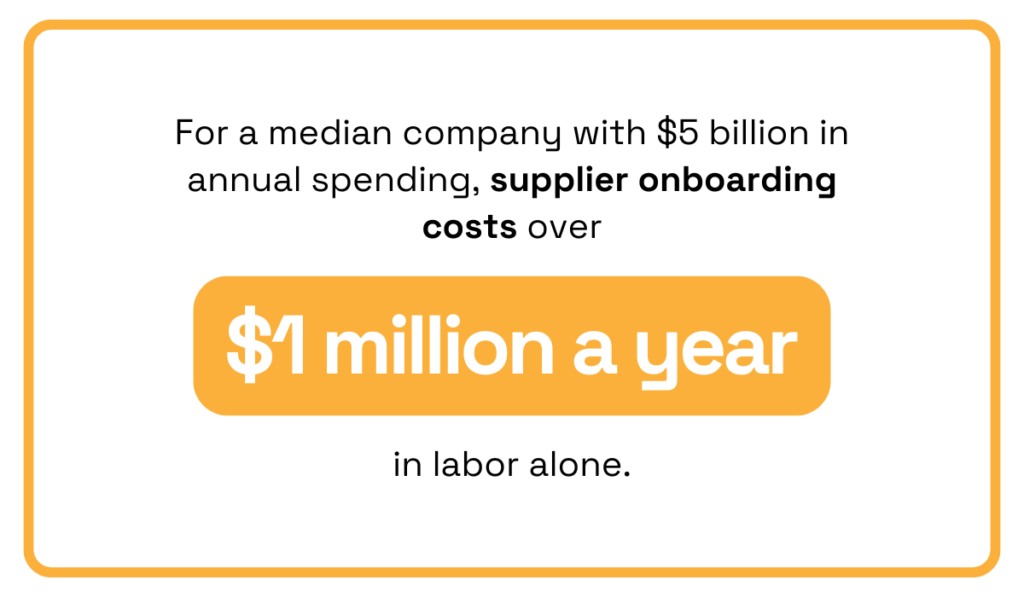
Illustration: Veridion / Data: HICX
That’s no small sum, particularly at a time when many businesses grapple with inflation, increasing costs, and tighter budgets.
A Keelvar survey reveals just how difficult it is.
As it turns out, 72% of procurement professionals face challenges due to rising costs.
To battle this issue, 68% of them plan to focus more on cost management and operational efficiency in 2024.
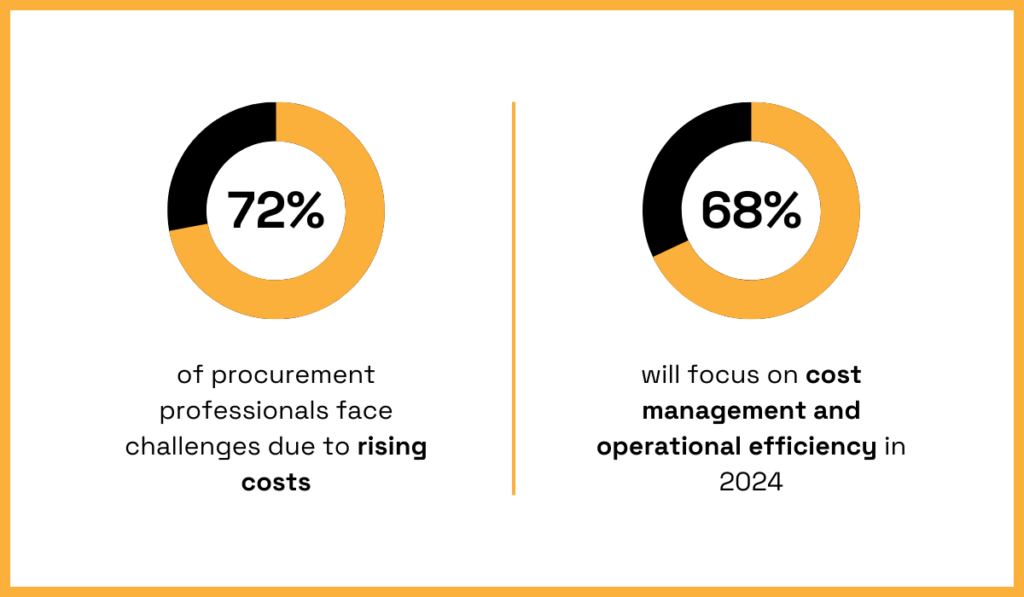
Illustration: Veridion / Data: Keelvar
Self-onboarding helps with both of these strategies.
Just ask Mitchells & Butlers (M&B), one of the UK’s largest operators of restaurants, pubs, and bars.
With approximately $1.3 billion in annual supplier spend, they faced significant (and costly) onboarding inefficiencies.
After all, that’s a lot of suppliers to onboard.
But after introducing a self-onboarding platform, this all changed, says Simon Madders, Project Implementation Manager at M&B:
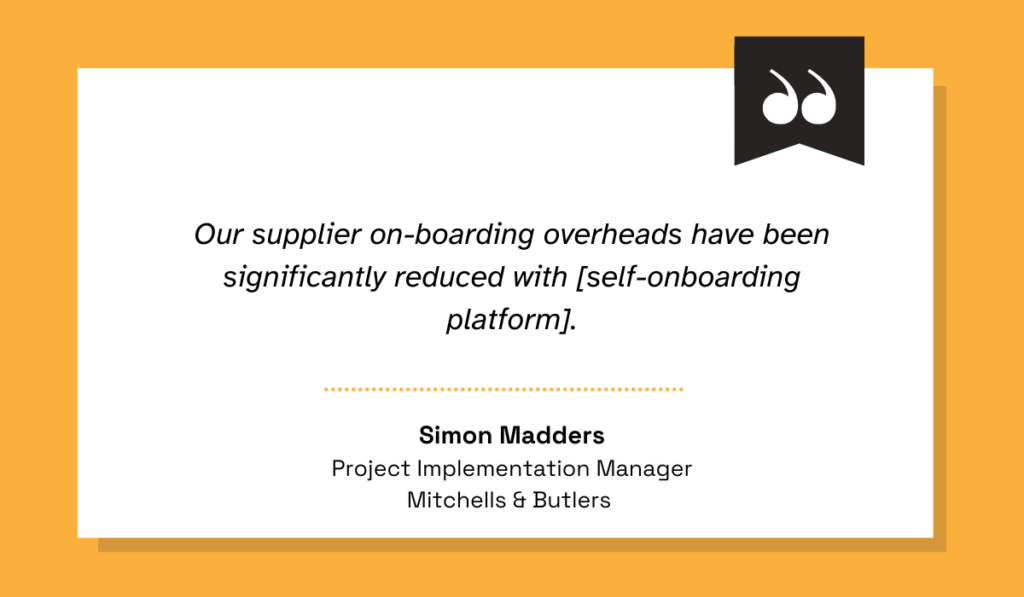
Illustration: Veridion / Quote: Medius
Before, onboarding a supplier could take three to four weeks.
It involved exchanging Word documents by post and manually entering data into payment systems.
Now, the process takes only a few hours, taking up fewer resources and boosting the bottom line.
And that right there is the real value of self-onboarding: it doesn’t just save you money.
It saves time as well.
Supplier self-onboarding represents a massive win for operational efficiency.
By allowing vendors to complete onboarding at their own pace and maintain their data, it cuts down on back-and-forth communication and reduces your team’s workload, saving valuable time.
And modern onboarding processes urgently need such improvements.
As supply chains become more strategic and data-intensive, onboarding requires far more than just checking delivery schedules and pricing.
Jim Fleming, Sr. Faculty Member at the Institute for Supply Management, explains how things used to be:
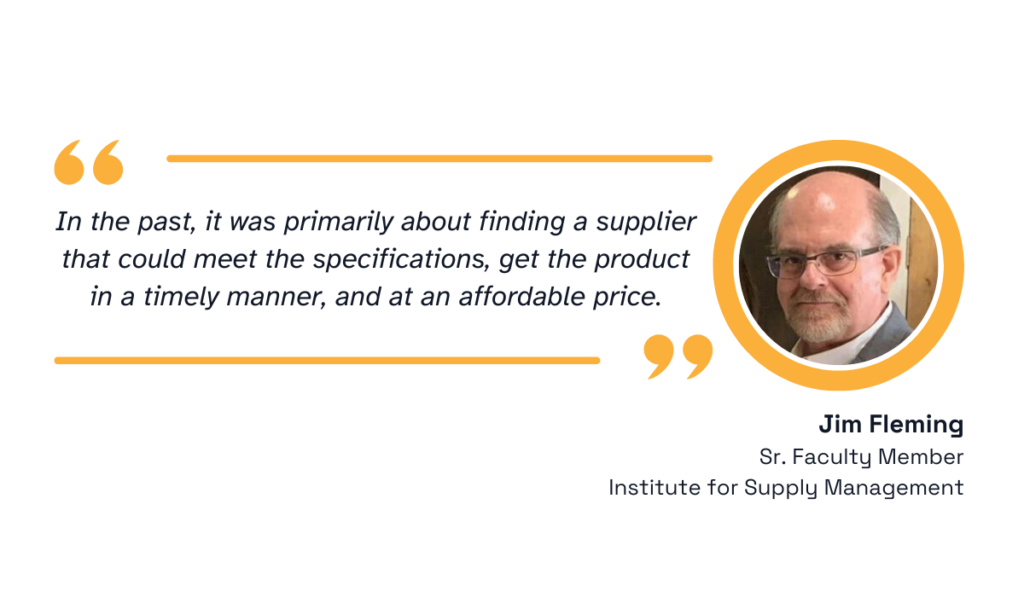
Illustration: Veridion / Quote: Institute for Supply Management
Today, that’s only the beginning.
You now have to collect information on sustainability practices, social responsibility, risk control, diversity programs, long-term goals, and so much more.
It’s a data-heavy process, and it makes way more sense to let suppliers fill it out themselves than have your team chase it down, piece by piece.
One Deloitte case study proved just how much more efficient self-onboarding can be.
One of the world’s leading automotive companies achieved a 400% increase in onboarding speed after implementing a self-onboarding platform.
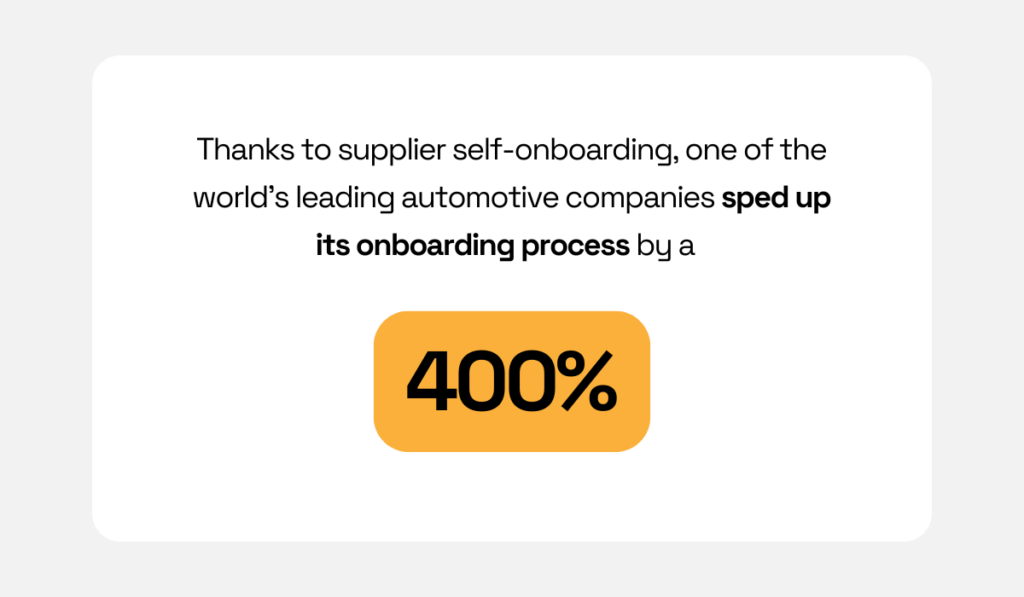
Illustration: Veridion / Data: Deloitte
Previously, their process was manual, plagued with endless phone calls, spreadsheets, and limited visibility into onboarding status.
Switching to a digital, self-service approach was a huge game-changer for them.
The company shared:
“The onboarding tool] not only made the onboarding process faster and easier, but we also reduced the risk of disruption from things like missed deadlines, lack of training, or IT ticketing to almost zero.”
The bottom line?
When suppliers self-onboard, companies unlock speed, transparency, and agility.
And in today’s volatile market, that agility can be the difference between staying ahead and falling behind.
Cutting down on excessive emails, paperwork, and phone calls creates a smoother experience, especially for small suppliers who don’t have dedicated administrative teams.
That’s exactly what self-onboarding does.
It gives the vendors more autonomy and flexibility, making their day-to-day much easier and more efficient.
And by prioritizing their experience from the very beginning, you make that strong first impression and lay the groundwork for a long-term, mutually beneficial partnership.
Ruth Bromley, former Director of Procurement Enablement at Heineken, agrees:
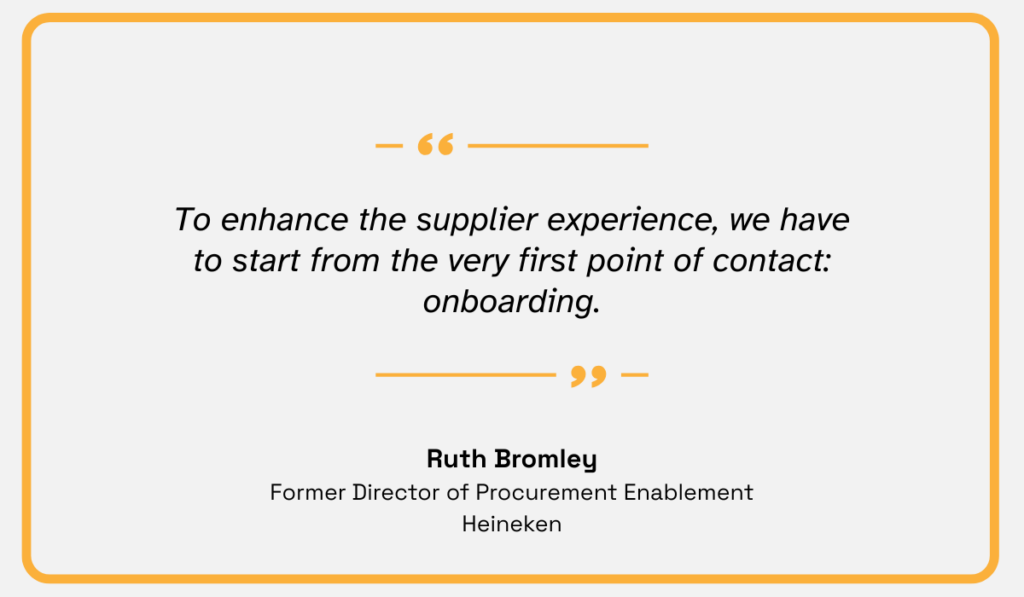
Illustration: Veridion / Quote: HICX
If that first interaction is clunky, time-consuming, or frustrating, chances are the rest of the relationship won’t go much better.
Put yourself in the supplier’s shoes: would you enjoy dealing with endless forms and follow-up emails?
Probably not.
Yet that’s the daily reality for many suppliers.
If you’re still not convinced, take a look at the 2024 HICX survey.
It reveals some valuable insights into how suppliers actually feel about their clients.
Apparently, 26% say buyers need to simplify their processes, while 61% report receiving too many information requests from their most important customers.
So, the buyers truly can make them feel overwhelmed. But here’s where it gets even more interesting.
If working with clients were easier, 53% say they would be willing to offer additional information voluntarily.
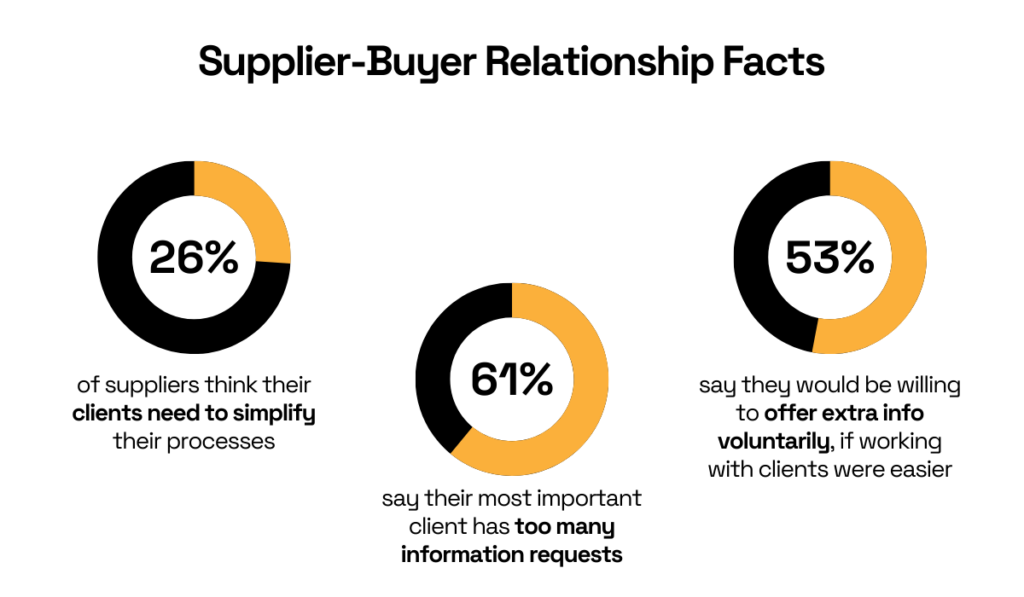
Illustration: Veridion / Data: HICX
The message is clear: make it easy to work with you, and your suppliers won’t just cooperate—they’ll go the extra mile for you.
Of course, supplier self-onboarding comes with its cons, too.
Let’s explore some of them.
Self-onboarding is supposed to make things easier for both you and your suppliers.
However, a poorly designed onboarding tool can have a completely different effect, frustrating users, causing confusion, and ultimately leading some suppliers to abandon the process altogether.
In many cases, it may also require manual intervention from your team, increasing their workload even further.
Kerry Young, President and COO of Bluemeteor, a product content lifecycle management platform, points out that this issue is more common than you might expect:
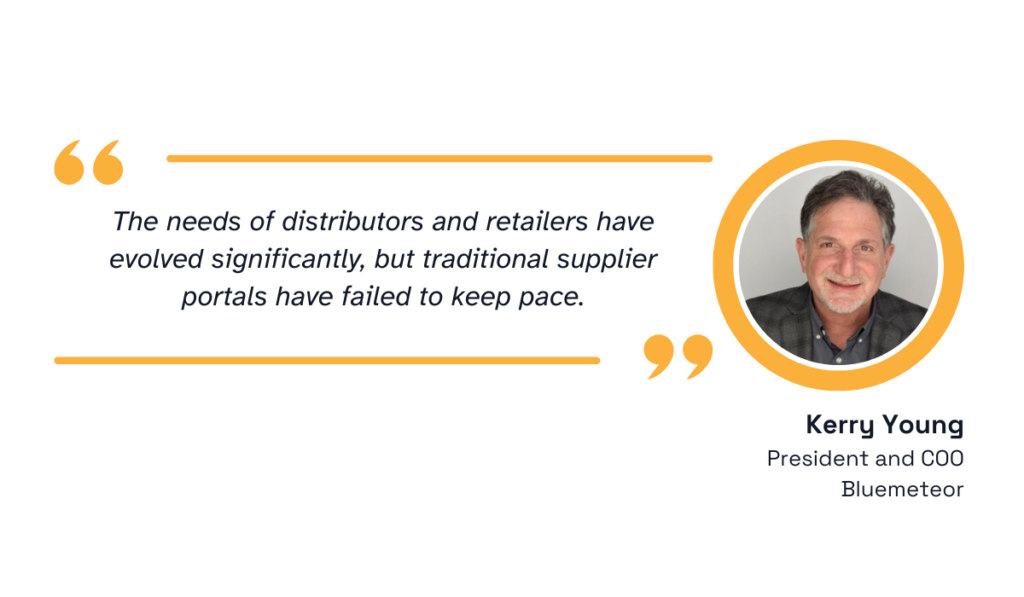
Illustration: Veridion / Quote: FOX40
Rather than simplifying data exchange, these outdated systems often add complexity, lack flexibility, and discourage supplier adoption, Young adds.
This is clearly the opposite of what self-onboarding is supposed to achieve.
Fortunately, there’s a practical solution: training.
Michael Nemeroff, Co-founder and CEO of RushOrderTees, a U.S.-based technology and custom apparel company, agrees.
At RushOrderTees, training is a cornerstone of successful supplier onboarding, he explains:
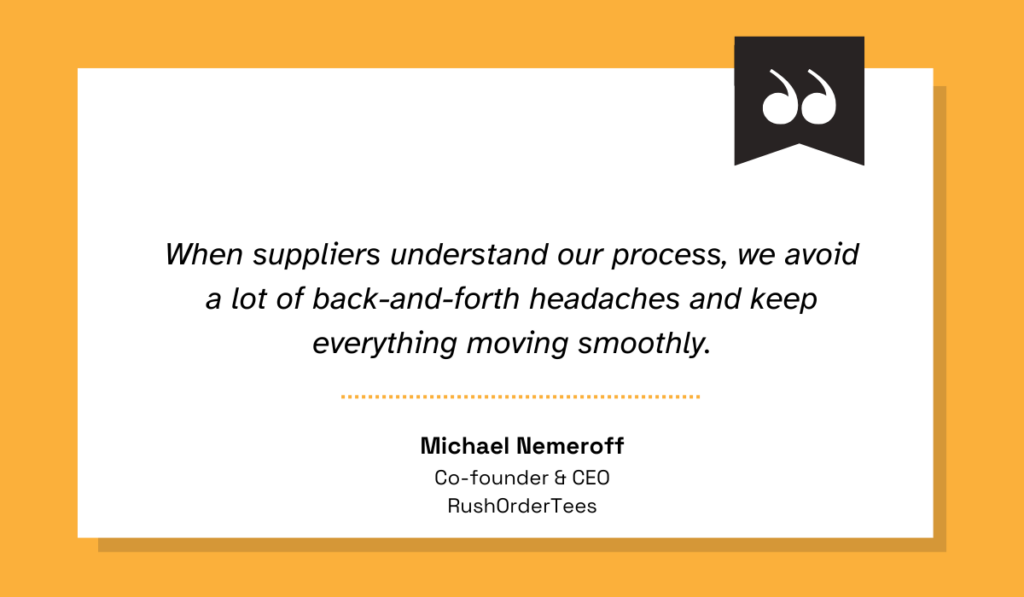
Illustration: Veridion / Quote: Softr
Effective training materials might include process walkthroughs, compliance reviews, and software tutorials.
In addition to one-time sessions during a supplier’s first week, you should also ensure that training resources stay accessible whenever they’re needed.
For instance, self-help centers and interactive online content can offer 24/7 support without the need for a support team.
Overall, simplicity should be the guiding principle in self-onboarding.
Without it, you risk negating all the potential benefits the process was designed to deliver.
When your suppliers self-onboard, there’s often less opportunity to discuss relevant compliance requirements and regulations directly.
So, how can they comply if they lack the necessary awareness, experience, or understanding of these standards?
Well, they can’t.
This is especially true today, when compliance is becoming increasingly complex for everyone.
Taylor Allis, Chief Product Officer at Avetta, a contractor risk management platform, explains:
“The supplier experience around company compliance programs has grown increasingly crucial as new regulations and requirements grow around contractor health and safety, ESG and sustainability, business risk, and cyber risk.”
Essentially, compliance isn’t just about quality standards anymore.
Today, it entails almost every aspect of business activity, which makes it hard for suppliers to keep up.
Unfortunately, self-onboarding only exacerbates the issue, lacking data checks and the necessary support from your organization, ultimately leading to misunderstanding.
Suppliers are left to guess what compliance looks like for you, and that guesswork creates risk.
Consider the example of Volkswagen Group brands like Porsche, Lamborghini, Bentley, and Audi.
In 2024, vehicles from these manufacturers were delayed at U.S. ports due to a supplier being found noncompliant with anti-forced labor laws.

Source: The Financial Times
They had to deal with delays, reputational damage, and a hit to the bottom line—all because of an issue they didn’t even know about.
So, even if you never directly violate any laws, a noncompliant supplier can be very dangerous.
And self-onboarding just makes the issue worse, because of little to no guidance or data verification on your end.
Self-reported data is notoriously unreliable.
Suppliers might make typos, omit key information, or submit inaccurate details.
Depending on the severity, these mistakes can cause serious issues, from delayed payments and communication breakdowns to increased costs.
After all, everything in procurement hinges on data.
When that data is accurate, you unlock significantly better procurement outcomes.
When it’s not, things fall apart.
Mitchell Zink, Senior Manager at Atrium, an industry leader in the Salesforce and Snowflake ecosystems, puts it this way:
“Data quality is the foundation for better decision making. With the explosion of data and advent of AI in the last few years, it’s become clear that data drives better [decisions], but only if your data is good.”
So, how do you ensure data reliability then?
Should you abandon supplier self-onboarding and revert to outdated methods?
Not at all. Self-onboarding is still highly effective and beneficial.
What you need is a tool that validates and enriches the data your suppliers provide.
That’s where AI-powered supplier intelligence platforms like our Veridion come in.
Here’s what we offer:
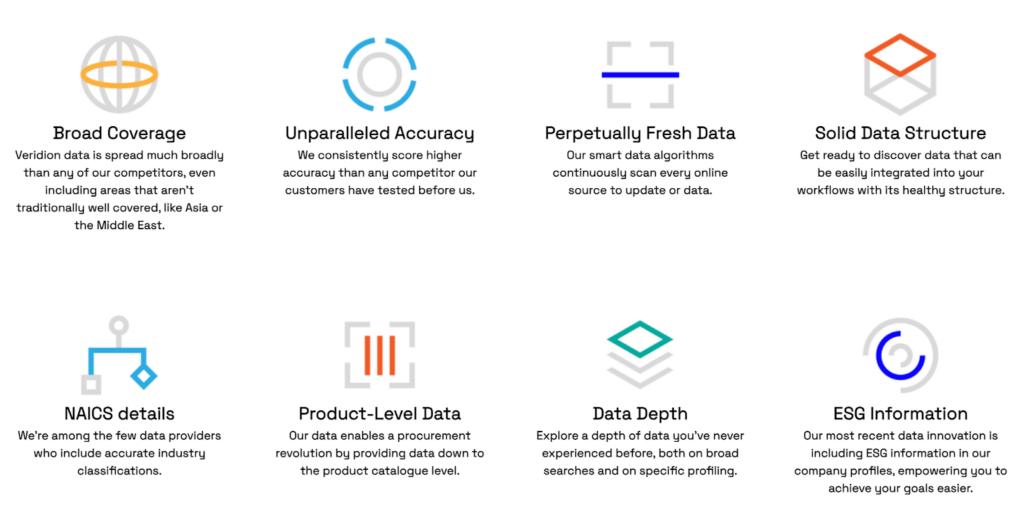
Source: Veridion
With a database of over 120 million companies, 68 data attributes, 200+ million locations, and weekly updates, Veridion delivers unmatched data depth, accuracy, and freshness.
In fact, compared to other B2B data providers, Veridion offers 30% better coverage and accuracy, and up to 50% more data points on average.
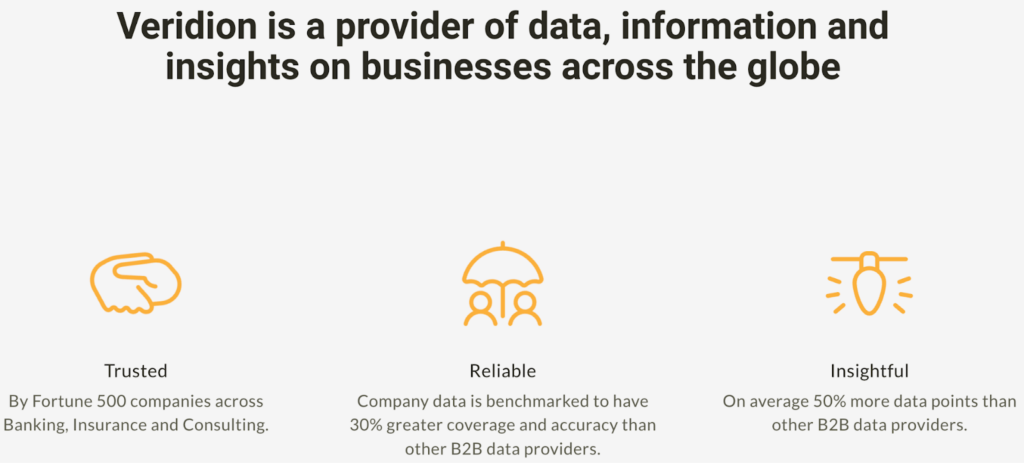
Source: Veridion
What does that mean for you?
It means you get real-time insights into all aspects of your suppliers’ operations, including ESG performance, financial health, geographic and operational risk, and so much more.
No gaps. No guesswork. No surprises.
Veridion doesn’t make mistakes or lose information.
It delivers the insights you need to make confident, informed decisions throughout the supplier management lifecycle.
Supplier self-onboarding is definitely not a silver bullet, but it can be a significant improvement for your operations.
Just like any process change, it demands intentionality, thoughtful execution, and the right tools to support your journey.
Do this right, and you’ll transform procurement from a clunky, resource-heavy bottleneck into a streamlined, data-driven advantage.
It’s definitely worth a shot.